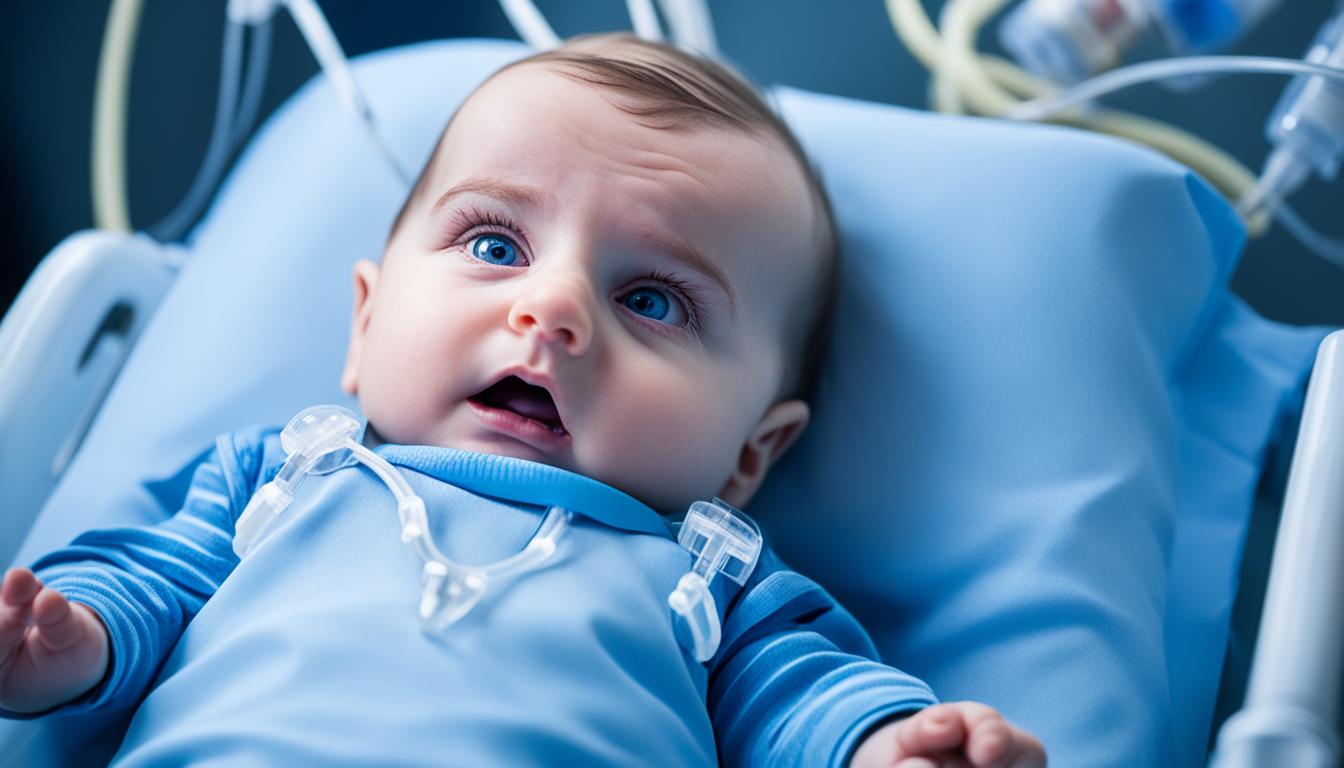Hypoplastic left heart syndrome (HLHS) is a heart defect that kids are born with. It affects how the left side of the heart works, like the left ventricle. This makes it hard for the heart to send blood to the body. The cause of HLHS isn’t clear, but genetics and things in the environment might play a part. Doctors often find HLHS before a baby is born or right after birth, using ultrasound and other tests. To help, kids with HLHS usually need a few surgeries. These are meant to fix their heart’s blood flow. Still, these surgeries can leave scar tissue on the heart. This can make the heart muscle weaker.
Key Takeaways:
- Hypoplastic left heart syndrome (HLHS) is a congenital heart defect affecting infants and children.
- The left side of the heart, including the left ventricle, is underdeveloped, leading to an inability to effectively pump blood to the body.
- The exact cause of HLHS is unknown, but it is believed to be a combination of genetic and environmental factors.
- Diagnosis of HLHS is typically made prenatally or shortly after birth through ultrasound and other imaging tests.
- Treatment for HLHS involves staged reconstruction surgeries, but these can result in scarring that weakens the myocardium.
Stem Cell Therapy for Hypoplastic Left Heart Syndrome
Researchers are looking into how stem cell therapy might help with Hypoplastic Left Heart Syndrome (HLHS). Stem cells can’t stay alive in the heart muscle, but they can release substances. These substances call other cells to the damaged spot, supporting growth and healing of the tissue.
A novel method involves putting a patient’s own umbilical cells back in their heart during surgeries. This method aims to lower scarring and make the right ventricle stronger. This is key in treating HLHS. The Mayo Clinic’s HLHS team is leading this exciting research, exploring the use of umbilical cells for treatment.
Stem cell therapy’s benefits for HLHS are still being checked. Yet, this method shows real promise in helping the heart work better. It offers hope for a better life for those with HLHS.
Benefits of Stem Cell Therapy for HLHS:
- Promotes regeneration of myocardial tissue
- Minimizes scarring caused by staged reconstruction surgeries
- Strengthens the right ventricle to improve circulation
- Offers potential for enhanced heart function and improved quality of life
HLHS treatment development depends a lot on research like stem cell therapy. By using stem cells to regenerate tissue and lessen scarring, doctors are exploring new paths in children’s heart care.
Current research directions:
| Research Focus | Description |
|---|---|
| Stem Cell Sourcing | Investigating the most effective methods for collecting and culturing umbilical cells |
| Optimal Administration | Exploring the best techniques for delivering stem cells to the heart during staged reconstruction surgeries |
| Long-Term Impact | Assessing the lasting effects of stem cell therapy on heart function and prognosis |
| Combination Therapies | Investigating the potential benefits of combining stem cell therapy with other treatment modalities |
We’re making progress in these research paths, but it’s early days for stem cell therapy in HLHS. We need strict tests and lots more research to see how good it can be. Yet, we’re very hopeful and excited about this new way that might help those with HLHS live better lives.
Prognosis and Challenges of Hypoplastic Left Heart Syndrome
The prognosis for children with HLHS is quite challenging. It affects the heart’s left side, making pumping blood difficult. Due to this, the right ventricle works harder to supply blood to the whole body.
The surgeries to help usually leave scars that can harm the heart. This makes managing HLHS and keeping the heart running well tough.
But, there’s hope from things like stem cell therapy. This treatment tries to mend the heart without scarring, using the patient’s own cells. Researchers think this could make the right ventricle stronger and the heart work better.
Dealing with HLHS’ heart and circulation problems, along with surgery scarring, is a big task. But new treatments are aiming to improve the future for kids with this condition.
Stay tuned for the next section, which will delve deeper into the potential of stem cell therapy as a promising treatment option for Hypoplastic Left Heart Syndrome.
Conclusion
Hypoplastic left heart syndrome (HLHS) is a serious heart disease that needs constant care. Although it’s tough for people with HLHS, there’s hope. New treatments like stem cell therapy are making a difference. They focus on boosting heart health and fixing scarring. This could change how we treat HLHS in the future.
Stem cells are being used to help heal hearts. They bring more cells to damaged areas. The Mayo Clinic is leading the way in using them. They’re collecting cells from umbilical cords to study and possibly use in surgery. This new therapy could be very promising for HLHS patients.
Many heart programs are working together to learn more about HLHS. They aim to find the best ways to treat it. The goal is to help hearts work better, reduce scarring, and improve life for those with HLHS. With doctors and researchers working so hard, there’s hope for a better tomorrow for patients and their families.

